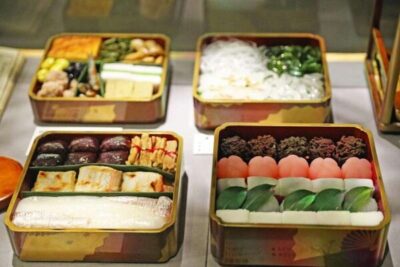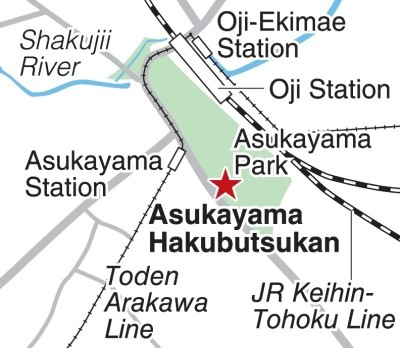
A visitor views various exhibits on display inside the Asukayama Hakubutsukan in Kita Ward, Tokyo. The exhibits, including a dugout canoe, were excavated in the ward.
16:03 JST, August 10, 2021
Asukayama in Kita Ward, Tokyo, is known for its popular cherry blossom viewing spot and as the place where Eiichi Shibusawa (1840-1931), the industrialist whose face is set to grace the next ¥10,000 note, spent his final years. But ruins from the Jomon period (ca 10,000 B.C.-ca 300 B.C.) to the Yayoi period (ca 300 B.C.-ca A.D. 300) are also hidden under the soil in the area.
The Asukayama Hakubutsukan (Asukayama museum) offers visitors the chance to chew off a bit of history from what is now Kita Ward.

A cross-section specimen of a shell mound discovered from the Nakazato Kaizuka shell mound characteristically contains shells of oyster and hamaguri clam and little else.
From the museum’s entrance on the second floor, visitors step into a permanent collection on the first floor where, in an atrium, a wooden structure measuring about 5 meters tall and 8 meters square is on display. It is a full-scale replica of a shoso, a storage unit used for unhulled rice that was collected as tax during the Nara period (710-784). The shoso storage unit is believed to have been built around the area, which was at one point called the Toshima-gun county of the Musashi-no-kuni domain. A life-size figure of a villager carrying a bag of unhulled rice stands in front of the store house, giving visitors a glimpse at a bygone lifestyle from another time.
Going deeper in the museum, the exhibits are split between 14 different themes in chronological order, starting from the Paleolithic age that feature fossils of a Naumann elephant’s teeth as well as a dugout vessel from the Jomon period.
Also on display is a cross-section specimen of a shell mound, which was excavated from the Nakazato Kaizuka shell mound, located between Tabata Station and Kami-Nakazato Station, from the mid-Jomon period. Visitors can get an up-close view of oyster and hamaguri clam shells in the shell mound.
According to the exhibits, Naumann elephants once roamed in the area around Tabata Station, which was part of an inland sea rich with seashells during the Paleolithic age. Such knowledge allows visitors to imagine what the area was like in prehistoric times.

A full-scale replica of a shoso, a storage house for unhulled rice collected as tax during the Nara period (710-784). The wooden structure is made of hinoki cypress, just like the ones built during the period.
The section devoted to the Yayoi period features a real-size replica of a pit dwelling house. A monitor installed in an opening designed to look like an entrance displays a video of intruders falling into a moat.
Of all the exhibits, the most popular one according to a museum staff in charge are the replicas of bento boxes that wealthy merchants and members of samurai households brought to cherry blossom viewing gatherings during the Edo period (1603-1867). Culinary researchers and other specialists studied antiquarian books and created the replicas, which contain gnomefish sashimi and dishes using round-nose flounders and other fish caught in what is now Tokyo Bay.
There are also replica houses fitted with flooding prevention techniques that were implemented due to an increase in flooding during the Meiji era (1868-1912) and a diorama of the Arakawa river in its current state.
Kita Ward spent 10 years getting the museum ready. Thanks to its efforts and ingenious ideas, visitors can have fun studying local history.

Replicas of wealthy people’s bento boxes for cherry blossom viewing during the Edo period (1603-1867).

Asukayama Hakubutsukan
1-1-3 Oji, Kita Ward, Tokyo.
"Culture" POPULAR ARTICLE
-

Van Cleef & Arpels Dazzles with Art Deco Artisanry at Tokyo Exhibit
-

Disney’s ‘Twisted-Wonderland’ Animated Series Puts Villains in Spotlight: New Show Features School Inspired by Classic Disney Films
-

Ayumi Hamasaki’s Shanghai Concert Canceled Day Before Schedule as Part of Beijing Backlash
-

‘The World Masterpiece Theater Series’ Celebrates 50 Years; Animator Looks Back on Creating Anime Classics
-

Popularity of Piggy Banks Across Time and Place Seen at Bank’s Museum of Money Boxes in Hyogo Pref.
JN ACCESS RANKING
-

Tokyo Economic Security Forum to Hold Inaugural Meeting Amid Tense Global Environment
-

Keidanren Chairman Yoshinobu Tsutsui Visits Kashiwazaki-Kariwa Nuclear Power Plant; Inspects New Emergency Safety System
-

Imports of Rare Earths from China Facing Delays, May Be Caused by Deterioration of Japan-China Relations
-

University of Tokyo Professor Discusses Japanese Economic Security in Interview Ahead of Forum
-

Japan Pulls out of Vietnam Nuclear Project, Complicating Hanoi’s Power Plans























